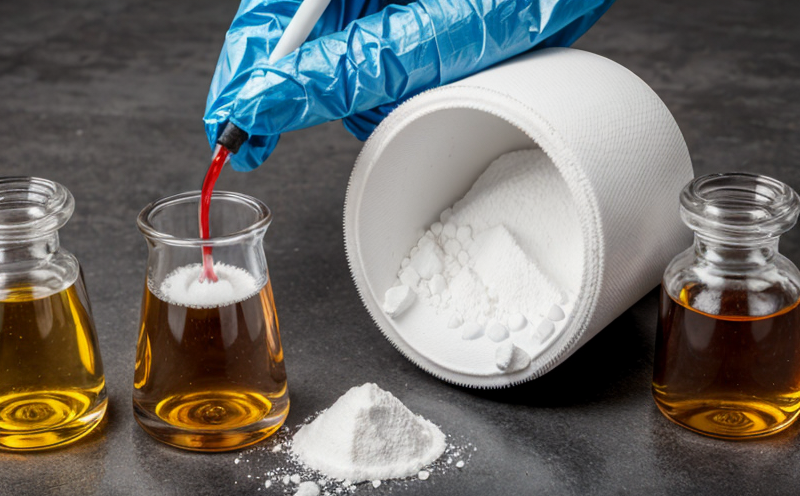ASTM D4236 Labeling of Hazardous Art Materials Testing
The ASTM D4236 standard is pivotal in ensuring that consumers are adequately informed about the hazards associated with art materials. This service focuses on the rigorous testing required to comply with this standard, which mandates the labeling and documentation of hazardous components present in these products. Compliance with ASTM D4236 is crucial for manufacturers, distributors, and retailers who handle or sell paints, markers, crayons, and other similar items.
The primary audience for this service includes quality managers, compliance officers, R&D engineers, and procurement specialists within the art materials sector. These professionals rely on accurate labeling to meet regulatory requirements while also ensuring product safety and integrity. This testing ensures that each material’s hazards are clearly communicated to consumers, thereby preventing potential misuse or accidental exposure.
Compliance with ASTM D4236 is not merely a compliance exercise but a commitment to public health and environmental protection. The standard mandates the identification of hazardous ingredients through rigorous chemical analysis. These analyses include testing for volatile organic compounds (VOCs), heavy metals, and other toxic substances that can pose risks when exposed in certain quantities.
During the testing process, samples are prepared by extracting potential hazardous components from the art materials using solvents. The extracted materials undergo quantitative analysis to determine their concentration levels accurately. This step is crucial as it ensures precise labeling of hazardous ingredients on the product packaging. The label must specify any components that exceed the threshold limits set by ASTM D4236, ensuring that consumers are fully informed.
The methodology employed in this testing process involves several key steps. Initially, the art materials undergo a preliminary screening to identify potential hazardous chemicals. This step is followed by a more detailed analysis using various analytical techniques such as chromatography and spectrometry. These advanced techniques allow for accurate quantification of hazardous substances present in the samples.
The final stage of this process involves preparing reports that document all findings from the chemical analyses conducted. These reports serve as official records, providing clear evidence of compliance with ASTM D4236 standards. The report typically includes detailed information on each identified hazardous component along with its concentration levels and any other relevant data required by the standard.
The importance of this service cannot be overstated in today’s regulatory landscape where public safety and environmental concerns are paramount. By adhering to ASTM D4236, manufacturers and distributors can protect their brands from potential legal issues while also contributing positively towards consumer health and safety.
| Applied Standards | Description |
|---|---|
| ASTM D4236 | This standard specifies the labeling requirements for hazardous art materials. It mandates that all potentially harmful components be clearly identified and documented. |
| ISO 17025 | The laboratory adheres to international standards ensuring accurate and reliable testing results. |
Applied Standards
| Standard | Description |
|---|---|
| ASTM D4236 | This standard specifies the labeling requirements for hazardous art materials. It mandates that all potentially harmful components be clearly identified and documented. |
| ISO 17025 | The laboratory adheres to international standards ensuring accurate and reliable testing results. |
Scope and Methodology
The scope of ASTM D4236 Labeling of Hazardous Art Materials Testing encompasses the chemical analysis necessary to identify hazardous components in art materials. The methodology involves several key steps, including preliminary screening, detailed analysis using advanced techniques such as chromatography and spectrometry, and preparation of comprehensive reports.
- Preliminary Screening: This step identifies potential hazardous chemicals present in the samples.
- Chemical Analysis: Advanced analytical techniques are used to quantify hazardous substances accurately.
- Report Preparation: Detailed records of all findings are compiled into official documentation.
The comprehensive nature of this testing ensures that manufacturers and distributors can confidently label their products according to ASTM D4236 requirements. This process not only meets regulatory demands but also enhances brand reputation by demonstrating a commitment to consumer safety and environmental responsibility.
Industry Applications
The application of ASTM D4236 Labeling of Hazardous Art Materials Testing extends beyond mere compliance; it plays a crucial role in ensuring product safety and integrity. This testing is particularly relevant for manufacturers, distributors, and retailers who handle or sell paints, markers, crayons, and other similar items.
- Manufacturers can use this service to verify that their products meet the stringent requirements set by ASTM D4236.
- Distributors benefit from having accurate information about the hazards associated with art materials they distribute.
- Retailers can provide safe and informed choices for their customers, thereby enhancing trust in the brand.
By adhering to ASTM D4236 standards, these organizations contribute positively towards consumer health and safety. Additionally, compliance helps protect brands from potential legal issues that could arise from non-compliance or misuse of hazardous materials.
| Industry Applications | Description |
|---|---|
| Manufacturers | Ensure product safety and integrity by verifying compliance with ASTM D4236 requirements. |
| Distributors | Provide accurate information about the hazards associated with art materials they distribute. |
| Retailers | Offer safe and informed choices for their customers, enhancing brand reputation. |





